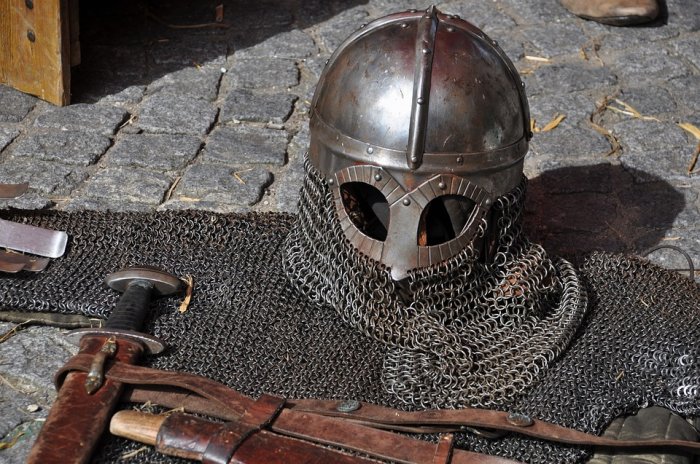Fascinating Medieval Knight Armor History
Rafael - AncientPages.com - In the past, every warrior that had to venture off into battle needed to protect themselves. In fact, it was the armor that aided in defining themselves as a social class and military unit. During the middle ages, armoring and protecting oneself was extremely expensive. It was a privilege for only those who could afford these gear.
A knight’s armor was specifically crafted for the medieval knight. It became their defining characteristic especially in battle. Their armor also represented the military unit they were part of. It was one of the best ways to exhibit their social class.
All in all, the armor of a medieval knight was highly important. This is most especially if the warrior wanted to survive on the bloody battlefield during the medieval era.
Throughout history, the medieval armor went through numerous developments and enhancements. Before the medieval era, the typical type of armor was made of the chainmail and leather. If you think about it, the materials used don’t seem to work well for protection. However, remember that weapons in the past were more primitive.
As weapons started evolving and improving, the medieval armor did so as well. And as time passed, the chainmail became more vital for a warrior. Its interlinked rings were highly effective against slash-type weapons, and were eventually used as an armor even after the medieval period.
When medieval warriors started integrating weapons that used blunt force, a more protective kind of armor was necessary. The very first of its kind was a metal breastplate. It proved to be efficient during battles; thus, gave the idea that covering the entire body with metallic plates was good.
After numerous trial and errors, the armor suit was developed. It also became the basic protective gear during battle, thus, becoming the knight’s armor that we know of today.
Different Medieval Knights Armor
During the medieval period, armor was classified into three types based on function: the jousting armor, ceremonial armor, and the field armor.
The field armor was designed specifically for combat. Its primary characteristics was that the armor was flexible and light. It allowed the knight to move easily while still receiving adequate protection.
Just like what its name states, the ceremonial armor was made for ceremonies. This is why it was intricately designed with gold, silver, copper, or cloth. Its appearance was highly important since it was a piece presented for important occasions. Lastly, the jousting armor was created for extreme protection even if it compromised the mobility of the user.
Different Parts Of A Medieval Knights Armor
Generally, it was basic knowledge that during the medieval period and in history, the gallant knights represented a group of elite warriors. This was the reason why blacksmiths established an armor that was crafted to be functional, practical, as well as decorative.
Here are all the parts that form and complete a knight’s medieval armor.
Helm
The helmet, which was often referred to as the helm, was vital for protecting the knight’s head and his face. Conical helmets were made from a sheet of iron or steel and some had interior bands to provide more strength. To add more comfort, the Knight helmets were padded and lined with leather; it also had grass, horse hair, or similar items.
The straps in the helmet and the scalloped lining on top were pulled together by a drawstring. This allowed for possible adjustments so the slit in the visor had the proper height. Another strap for the chin was also present. This was to keep the helmet in place. There were also ventilation holes that were added to the lower front portion of the helm. This allowed the user to have adequate breathing. During the 1330 CE, visors protruded from the helmet which allowed the user easier and better breathing. Other helmets had a bevor or plate hanging down to keep the throat safe.
Another type of helmet was the kettle hat. Although it was not commonly used by knights, it was still a choice for other warriors.
Breastplate
The breastplate became more widely used around the mid-14th century CE. This armor was specifically made to protect the stomach. It was also mounted over a placard using a few hinges and was worn in a way that it could be easily worn or removed.
Breastplates were curved, and at times, these featured certain arrangements of flexible metal hoops or strips around the waist area. These were attached with the help of buckles, straps, or semicircular rivets. Occasionally, knights wore a simpler backplate and the breastplate was attached to the front plate using hinges.
Leg Armor
The leg armor came in two types: the greaves or metal shin guards which protected the lower legs, and the poleyns or bendable types of armor. Even if the maille shirt’s skirt or the cuirass’ tassets were able to protect ones upper legs, the armor can still be avoided if an opponent thrusts from below.
This is why cuisses were worn to guard against such blows. Padded cuisses that were made like the gambeson were often worn by knights around the 12th and 13th centuries. These were worn over chausses and poleyns and may also have been directly attached to the cuisses.
Vambraces and Gauntlets
Vambraces were made to protect the arms of the wearer, while the gauntlets protected the hands and wrists. For vambraces, these can be worn with or without separate couters in a full suit of medieval armor. These were made from either steel or boiled leather and were occasionally reinforced with longitudinal strips of hardened hide.
Chainmail
The chainmail was one of the earliest metallic armor that medieval knights wore. It was made of thousands of interlocked rings that were handwoven to form a mesh shirt, coif, or leggings.
Since mild steel was produced in the medieval period, each of the rings had to be riveted. This was to prevent the rings from spreading and opening. The chainmail served as an additional form of protection underneath the armor, thus keeping the exposed areas of the user, safe.
Written by – Rafael - AncientPages.com
Copyright © AncientPages.com All rights reserved. This material may not be published, broadcast, rewritten or redistributed in whole or part without the express written permission of AncientPages.com
More From Ancient Pages
-
 Remarkable Discovery Of Ancient Drilled Bear Teeth In Kansas – How Did They End Up On The Great Plains?
Archaeology | Mar 25, 2022
Remarkable Discovery Of Ancient Drilled Bear Teeth In Kansas – How Did They End Up On The Great Plains?
Archaeology | Mar 25, 2022 -
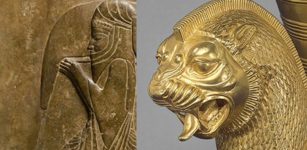 Peace Of Callias – A Treaty That Ended The Greco-Persian Wars
Ancient History Facts | May 15, 2019
Peace Of Callias – A Treaty That Ended The Greco-Persian Wars
Ancient History Facts | May 15, 2019 -
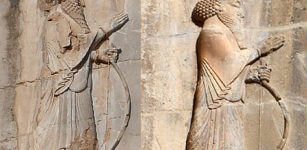 Naqsh-e Rostam: Spectacular Tomb Complex With Rock Reliefs From Elamite To Sasanian Times
Civilizations | Nov 15, 2018
Naqsh-e Rostam: Spectacular Tomb Complex With Rock Reliefs From Elamite To Sasanian Times
Civilizations | Nov 15, 2018 -
 Invasion Of Mysterious Sea People – Enigmatic 3,200-Year-Old Luwian Hieroglyphic Inscription Sheds New Light On Ancient Puzzle
Archaeology | Oct 11, 2017
Invasion Of Mysterious Sea People – Enigmatic 3,200-Year-Old Luwian Hieroglyphic Inscription Sheds New Light On Ancient Puzzle
Archaeology | Oct 11, 2017 -
 Moll Cutpurse – London’s Queen Of Thieves
Featured Stories | Jan 15, 2019
Moll Cutpurse – London’s Queen Of Thieves
Featured Stories | Jan 15, 2019 -
 Ancient Secrets Of The Theopetra Cave: World’s Oldest Man-Made Structure And Home To Humans 130,000 Years Ago
Civilizations | May 12, 2016
Ancient Secrets Of The Theopetra Cave: World’s Oldest Man-Made Structure And Home To Humans 130,000 Years Ago
Civilizations | May 12, 2016 -
 Mysterious Advanced Underground Civilization And A Secret Society – Astonishing Discovery And Connection – Part 1
Civilizations | Apr 21, 2018
Mysterious Advanced Underground Civilization And A Secret Society – Astonishing Discovery And Connection – Part 1
Civilizations | Apr 21, 2018 -
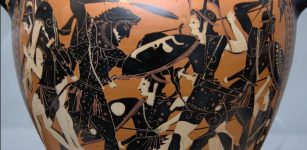 Did The Amazons Really Exist? – Truth Behind Myths Of Fierce Female Warriors
Featured Stories | Oct 29, 2014
Did The Amazons Really Exist? – Truth Behind Myths Of Fierce Female Warriors
Featured Stories | Oct 29, 2014 -
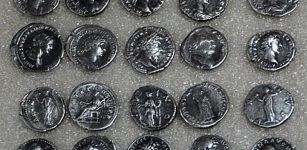 Bulgarian Archaeologists Find Nearly 3000 Coins In Clay Pot At Sofia Dig
News | Sep 8, 2015
Bulgarian Archaeologists Find Nearly 3000 Coins In Clay Pot At Sofia Dig
News | Sep 8, 2015 -
 On This Day In History: Universal Declaration Of Human Rights Adopted – On Dec 10, 1948
News | Dec 9, 2016
On This Day In History: Universal Declaration Of Human Rights Adopted – On Dec 10, 1948
News | Dec 9, 2016 -
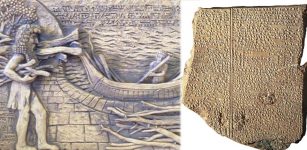 Utnapishtim And The Babylonian Flood Story
Featured Stories | Jan 28, 2016
Utnapishtim And The Babylonian Flood Story
Featured Stories | Jan 28, 2016 -
 Stunning 3,400-Year-Old Palace Of the Kingdom Of Mitanni Discovered Thanks To Drought
Archaeology | Jun 27, 2019
Stunning 3,400-Year-Old Palace Of the Kingdom Of Mitanni Discovered Thanks To Drought
Archaeology | Jun 27, 2019 -
 Excavations of the Aşıklı Mound, Cappadocia , Turkey
Civilizations | Aug 22, 2015
Excavations of the Aşıklı Mound, Cappadocia , Turkey
Civilizations | Aug 22, 2015 -
 Researchers Confirm Museum Shrunken Head As Human Remains
Archaeology | Aug 4, 2022
Researchers Confirm Museum Shrunken Head As Human Remains
Archaeology | Aug 4, 2022 -
 Dozens Of Unique 2,500-Year-Old Ceremonial Treasures Discovered In A Drained Peat Bog
Archaeology | Jan 27, 2023
Dozens Of Unique 2,500-Year-Old Ceremonial Treasures Discovered In A Drained Peat Bog
Archaeology | Jan 27, 2023 -
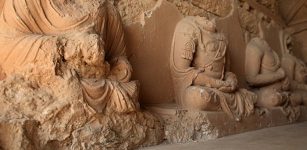 Takshashila: Renowned Learning Center That Attracted Buddhist Masters, Disciples And Students Of The World
Featured Stories | Jul 23, 2016
Takshashila: Renowned Learning Center That Attracted Buddhist Masters, Disciples And Students Of The World
Featured Stories | Jul 23, 2016 -
 Surprising Discovery Of Almost Intact Roman Sanctuary With Temples In The Netherlands
Archaeology | Dec 23, 2022
Surprising Discovery Of Almost Intact Roman Sanctuary With Temples In The Netherlands
Archaeology | Dec 23, 2022 -
 Sun: Highest Cosmic Power Worshiped By Ancient People And Represented By Deities
Featured Stories | Apr 1, 2019
Sun: Highest Cosmic Power Worshiped By Ancient People And Represented By Deities
Featured Stories | Apr 1, 2019 -
 3,700-Year-Old Domed Oven Found At Troy Excavation Site Closely Related To Anatolian Culture
Archaeology | Sep 12, 2022
3,700-Year-Old Domed Oven Found At Troy Excavation Site Closely Related To Anatolian Culture
Archaeology | Sep 12, 2022 -
 Modern Pesticide Accelerates Corrosion Of Ancient Roman Bowl
Archaeology | Oct 6, 2022
Modern Pesticide Accelerates Corrosion Of Ancient Roman Bowl
Archaeology | Oct 6, 2022


